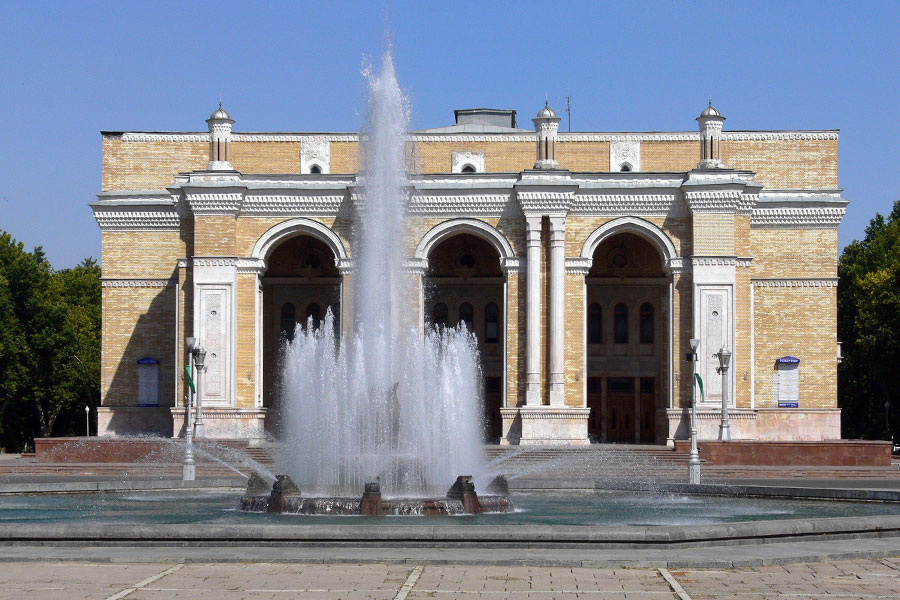Opera and Ballet Theatre named after Alisher Navoi, Tashkent

Address: 28, Ataturk Str., Tashkent, 100029
Phone: (+998 71) 233 90 81
E-mail: gabtuzb@mail.ru
Web-site: http://www.gabt.uz
Plays are held: Weekdays at 18:00; Saturday and Sunday at 17:00 Sunday at 12:00 - special childrens program
Day off: Monday
The Alisher Navoi Opera and Ballet Theatre is the largest, and most unique theatre on the territory of Central and Southeast Asia. Its achievements are of great value to the Uzbek people, the pride of the nation.
The following season, the theatre will be celebrating its 75th anniversary. Thumbing through the pages of the history of its creation and development, we are convinced that, alongside the fulfillment of its major mission of familiarizing people with samples of international and Uzbek musical culture, the theatre aspires to expand the horizons of its importance, and to take a worthy place in the world cultural arena. This is supported by the successful performances of the theatre abroad, the participation of our soloists in international festivals and competitions, and the realization of interesting international projects. In the last three years alone, the theatre has accepted many guest performers on its stage, such as conductors Saim Akchil, professor of Istanbul University of Music; Pierre Dominique Panelli from Germany (three times); Lawrence Golana from the USA, Paolo Longo from France, and Giovanni Guerrieri from Italy.
With great success, soloists of the operas of Korea and Japan, soloists of the ballet of Japan, Russia, Ukraine, France and the Great Britain have acted on the theatre stage.
The arena of international performances has been opened wide for our artists. The big symphonic orchestra of the theatre has recorded its first CD in Malaysia; the ballet troupe, during the last five years, has carried out a number of exchange performances with the troupe " Toyota-city ballet " (Japan); the teacher tutor of ballet and national actress of Uzbekistan, V. Proskurina, has been invited to work in the " Toyota-city ballet "; the main ballet master of the theatre, national actor of Uzbekistan, I. Jusupov, has been invited for a performance "Nutcracker" in Turkey; and the famous ballerina, national actress B. Karieva, has repeatedly participated as a judge in the largest competitions of young soloists of ballet in Italy and the USA.
In creative terms, the troupe of the theatre is constantly searching, with quarterly updates and supplements to the repertoire. In the search of new forms and ways of realization of the progressive ideas of opera and ballet art, the Uzbek theatre is confidently taking the path of creation.
During its creation and formation, the collective of the Uzbek musical theatre had no theatrical building of their own. National architecture had no experience in the construction of secular municipal buildings, especially such large structures in which it would be possible to seat significant numbers of spectators and give performances. In the only building constructed at the beginning of 20th century, an entertainment establishment, in the building of the former theatre "Coliseum", two troupes of Russian and Uzbek musical theatres worked in the Thirties. Performances were given every day. Despite the reconstruction of the stage and building, the hall was not adequate to meet the requirements for the production of classical and Uzbek performances. The government of the Republic of Uzbekistan made the decision on the construction of a theatrical building, corresponding to the rise of national cultural growth that the Republic was experiencing during the 1930s.
A State competition for the creation of the project of the theatrical building, with the condition of publication in the press of projects and their wide discussion and public debate, was declared. On the results of the competition, the proposal of the academician of architecture, A. V. Shusev, won. It was recognized as the most adequate for functional tasks and the national traditions of architecture. In 1939 construction began, but was interrupted in 1942, in light of the difficulties connected with World War Two. In 1944, after the military crisis subsided, construction was restarted. In November 1945, Japanese prisoners of war were deported to Tashkent from the Quantoon army, and took part in the finishing stages of construction work. National artists of Uzbekistan, Usta Shirin Muradov, A. Hudajbergenov, and H. Boltaev showed their skill in decorative work.
According to the plan of the author of the project, each lateral foyer (6 in the theatre) began to assume the character of the architectural decor inherent in various regions of Uzbekistan. Tashkent Hall, Bukhara Hall, Khorezm Hall, Samarkand Hall, Fergana Hall and Termez Hall have their own styles and features. For example, for Bukhara Hall, masters chose and executed such unique techniques of decor as groove on gunch, imposed on a smooth surface. Such elements of ornament were used for the first time in the construction of the Bukhara Emir palace. Khorezm Hall has carved panels of gunch, repeating the remarkable decorative woodcarving, characteristics of Khorezm. The halls and foyer of the theatre are decorated with murals depicting plots from A. Navoi's poems and representing the landscapes of Uzbekistan. The creators of the decorations are artists of Uzbekistan, such as C. Ahmarov, A. Tatevosjan, etc.
After the termination of the construction of the theatre, at the offer of academician A. V. Shuseva, the fountain in front of the portal was built. They finished the creation of the architectural ensemble, which has become a remarkable landmark of the capital. From the date of the opening of the theatre in November, 1947, it has been not only a building where remarkable performances are given, but also a location for solemn events in the life of the Republic. This tradition continues today. Many foreign representatives also consider it an honor to carry out their activities on the stage of the Theater.

